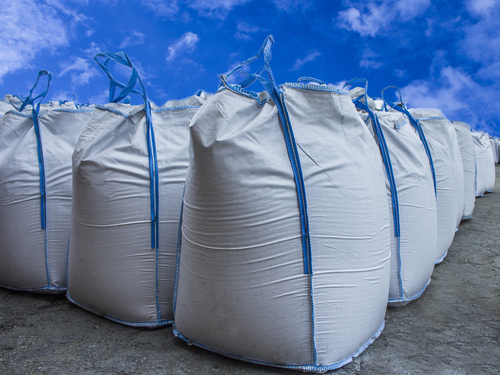
If you’re shopping for super sack bags, otherwise known as flexible intermediate bulk containers (FIBC bags) or one-ton bags, there are a few things you need to take into consideration. While these heavy-duty bags are great for integrating into your warehouse, distribution center, shipping facility or manufacturing plant—they work well with your forklift and palletizer and are easy to introduce to any supply chain—not every super sack container is best for every application. Here are some important things to keep in mind when buying and using these jumbo bags.
1. Some Can Be Used for Hazardous Materials
As you may know, the transport of hazardous materials is heavily regulated by the United Nations, as these dangerous materials could pose a significant threat to people and the environment. For that reason, you need to reference the U.N. Orange Book—officially known as the U.N. Recommendations on the Transport of Dangerous Goods Model Regulations—anytime you’re considering shipping hazardous goods, not only in North America but around the globe. As long as you’re purchasing U.N.-certified FIBC bags, you can use them for your hazardous shipping and packaging solutions.
2. Not All Jumbo Bags Are Created Equal
A jumbo bag is a jumbo bag, right? Not so fast. Super sack bags come in a variety of different styles. The most popular styles are spout bags, which feature either a spout bottom or spout top to make filling and discharge easier. The majority of the FIBC bags you’ll find are made of a durable, high-quality polypropylene fabric, but some have been treated so that they’re appropriate for use in specific applications. For example, you will find bulk bag styles that are treated for anti-static applications and styles made of polyethylene or food-grade materials to meet your specific needs.
3. They Can Be Recycled and Reused
 One of the reasons why many facilities choose the FIBC bag over other kinds of heavy-duty bulk bags is because they can be recycled again and again. In fact, the Flexible Intermediate Bulk Container Association (FIBCA) recommends that these bags be recycled at the end of their life whenever possible. Various companies around the country are designated as FIBC and bulk bag recyclers and make turning in your bags for reuse simple and hassle-free.
One of the reasons why many facilities choose the FIBC bag over other kinds of heavy-duty bulk bags is because they can be recycled again and again. In fact, the Flexible Intermediate Bulk Container Association (FIBCA) recommends that these bags be recycled at the end of their life whenever possible. Various companies around the country are designated as FIBC and bulk bag recyclers and make turning in your bags for reuse simple and hassle-free.
4. They’re Not Just for Shipping
Many people think that these bags are only used for shipping applications. Indeed, that’s one of the main reasons why a super sack container might be employed. However, because they feature super-durable lift loops, they can be easily lifted and maneuvered by a forklift. Additionally, you might find that your big bag features a document pouch for displaying labels or information, which helps make these bags great for use in storage and warehousing. You can easily integrate machinery such as a bulk bag unloader into your supply chain for added efficiency.
5. They Can Be Used for Food Storage and Shipping
The rule for food-grade FIBC bags is the same as the rule for hazardous materials. Not all jumbo bags are designed for storing or shipping food items, but some are manufactured with materials that are safe for such applications. Typically, food-grade jumbo bags are made with the same durable plastic materials as standard ones, but often feature special treatments and preparation methods to ensure that they don’t come into contact with any harmful materials or bacteria. You can even buy bulk bags that are Kosher- and Halal-certified for specific food handling applications.

6. They’re for More Than Just Bulk Material
When you think of these kinds of bags, you usually think of using them with granular bag fillers, such as sand, fertilizer, powders and other flowable materials—hence why they’re sometimes called jumbo sand bags. But, depending on the classification, these bags can be used for other materials, too, including electronics, plastic parts, chemicals, food items, steel and much more. FIBC containers are rated from Type A to Type D, which corresponds to the bag’s level of static protection. If you plan to use this kind of bag for electronics, metals or other kinds of parts that require static dissipation, make sure to pay close attention to the FIBC classification.
